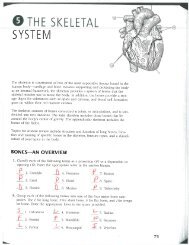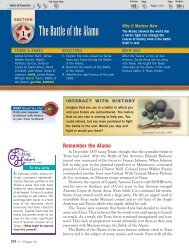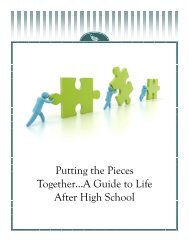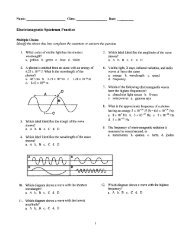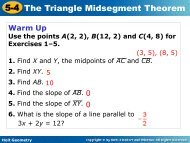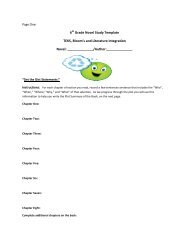Phys. Chapter 08 - Beau Chene High School Home Page
Phys. Chapter 08 - Beau Chene High School Home Page
Phys. Chapter 08 - Beau Chene High School Home Page
- No tags were found...
Create successful ePaper yourself
Turn your PDF publications into a flip-book with our unique Google optimized e-Paper software.
Electron spinIn addition to the orbital angular momentum of the electron, certain experimentalevidence led scientists to postulate another type of angular momentumof the electron. This type of angular momentum is known as spinbecause the effects it explains are those that would result if the electron wereto spin on its axis, much like the Earth spins on its axis of rotation. Scientistsfirst imagined that the electron actually spins in this way, but it soon becameclear that electron spin is not a literal description. Instead, electron spin is aproperty that is independent of the electron’s motion in space. In this respect,electron spin is very different from the spin of the Earth.Just as a wheel can turn either clockwise or counterclockwise, there are twopossible types of electron spin, spin up and spin down, as shown in Figure8-18. Thus, like orbital angular momentum, spin is quantized. Because theelectron isn’t really spinning in space, it should not be assumed that Figure8-18 is a physical description of the electron’s motion.(a)Spin downSpin upConservation of angular momentumAlthough the quantum-mechanical concept of angular momentum is radicallydifferent from the classical concept of angular momentum, there is onefundamental similarity between the two models. Earlier in this chapter, youlearned that angular momentum is always conserved. This principle still holdsin quantum mechanics, where the total angular momentum, that is, the sumof the orbital angular momentum and spin, is always conserved.As you have seen, the quantum-mechanical model of the atom cannot bevisualized in the same way that previous atomic models could be. Althoughthis may initially seem like a flaw of the modern theory, the accuracy of predictionsbased on quantum mechanics has convinced many scientists that physicalmodels based on our experiences in the macroscopic realm cannot provide acomplete picture of nature. Consequently, mathematical models must be usedto describe the microscopic realm of atoms and subatomic particles.(b)Figure 8-18In the quantum-mechanicalmodel of the atom, the electronhas both an orbital angularmomentum and an intrinsicangular momentum, known asspin. (a) Spin up and (b) spindown are the only possible valuesfor electron spin.Table 8-8Angular momentumClassical angular momentumcorresponds to a literal rotationcan have any possible valuetotal angular momentum(orbital + rotational) conservedQuantum angular momentumdoes not correspond to a literalrotationcan have only certain discretevaluestotal angular momentum (orbitalangular momentum + spin)conservedNSTATOPIC: Rutherford model of atomGO TO: www.scilinks.orgsciLINKS CODE: HF2<strong>08</strong>4Copyright © by Holt, Rinehart and Winston. All rights reserved.Rotational Equilibrium and Dynamics303



